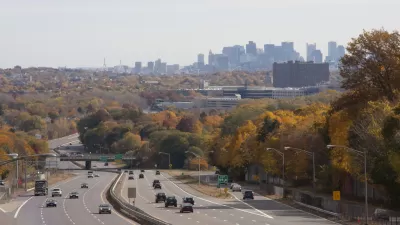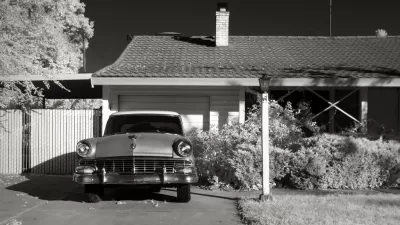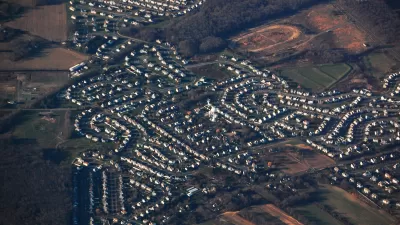Suburbia

Job Sprawl and Commuting Times
Suburbanization has not led to shorter commutes—except perhaps for residents of the most job-rich, affluent suburbs.

Can the Garden Suburb Save the Suburbs?
“Can Paradise be Planned?” asks Allison Arieff in a recent op-ed. The article discusses new books by architect Robert A.M. Stern and photographer Christoph Gielen to look for reasons for optimism with regard to suburbs and planning.
The Creation of a "Drive to Qualify" World
The cost of intown housing makes suburbia fiscally tempting- but this is in part the result of deliberate policy choices by government.
Mount Laurel Attests to the Benefits of Integrating Suburbia
Despite their fears, the well-off residents of Mount Laurel have been unaffected by the “fair share” of affordable housing mandated by the U.S. Supreme Court in the landmark battle over the socioeconomic integration of suburbia.
House Hunting? Run the Numbers Before Running to the ‘Burbs
As housing (un)affordability continues to plague Canada’s big cities, some would-be city dwellers are looking to the suburbs to meet the budget. Using a hypothetical Toronto couple as its basis, number-crunching suggests little long-term savings.

The Suburbs Are Deficient Because We Made Them That Way
With their unhealthy environments, unsustainability, and relatively poor return on investment, "the suburbs" are an easy target for criticism. But suburbs aren't inherently inadequate, says David Levinson, they suffer from poor postwar urban design.

The Outer Limits of Walk Score
Planning professor Doug Kelbaugh lives in one of the few neighborhoods outside Manhattan with a perfect 100 Walk Score. His brother's house in South Carolina has a Walk Score of 1. Kelbaugh reflects on the extremes, and what they mean.

Why 'Leave it to Beaver' Neighborhoods are Ripe for Renewal
The nation has a huge quantity of postwar housing that can be made more walkable and appealing to new generations of residents. Robert Steuteville examines what makes them good candidates and notes some examples of successful retrofits.
Suburban Poor? Are You Sure?
Brookings Institute's “Confronting Suburban Poverty” is generating a lot of buzz. Community development leaders and planners took to Rooflines to voice opinions and critiques of the book, moving its authors to submit a response that you must read.

Cities May Be Back, But Don't Forget About the Burbs
A review of June Williamson's new book reminds us that the need to retrofit suburbia is as urgent as ever, despite the ascendance of cities. Amanda Kolson Hurley explores the top five reasons 'why the suburbs are shaping up as the new frontier.'
Atlanta Artist Paints Suburban Ennui
Today's suburbs have discarded the human-scaled patterns they once promised. This newly resurfaced series of paintings from Atlanta artist Meg Aubrey will leave you longing for the world we neglected to build.
Postwar Suburbia from the Air
On Places, D.J. Waldie assesses iconic aerial photographs of Lakewood, California, one of the nation's first postwar planned communities.
Marching Towards More Walkable Communities
Richard Florida interviews Jeff Speck about his new and highly praised book "Walkable City." The two authors discuss why cities should become more walkable to meet the needs of the "Walking Generation."
Suburbs Become the New Cities
Small towns like Carmel, Indiana have gained national prominence after redeveloping into "cities where people can live, work and play," writes Haya El Nassar.
The Diminishing Meaning of "Urban" and "Suburban"
To some, "the suburbs" mean bland neighborhoods outside of a vibrant city life. But demographic and land-use changes are making Lakis Polycarpou and others rethink the definitions of "urban" and "suburban."
An Argument for Housing Choice
Trying to thread the needle between those who celebrate the demise of the exurb and those who bemoan smart growth policies, Edward Glaeser argues that we can, and should, have it all when it comes to housing choice in America.
Rethinking Suburban Design
Architect Alan Chang writes an extensive piece for PLACES on the need to rethink how suburbs are built and designed now, before the economy recovers.
Farm Chic is the Latest Trend in Housing Developments
In the '00s, housing built around golf courses was all the rage. Stephanie Simon reports that today's consumer wants to live next to an organic farm, vineyard or other micro-rural setting.
Cleanliness from a car
A few months ago, I was talking to a faculty colleague who lives in a part of Jacksonville even more sprawl-bound where I live, an area about a mile or so from the nearest bus stop and with a single-digit Walkscore. He said Jacksonville was "safe and clean." I was a little surprised: "clean" is one word I would never* use to describe Jacksonville. When I walk down the sidewalks of San Jose Boulevard, I notice litter aplenty - and from what I know of Beach Boulevard (the grim commercial strip near my colleague's house) I doubt that it is much better.
Graying of the Suburban Image
The 2010 Census showed that the baby-boom generation led to the growth of older populations settling in suburbs, which is causing local governments to rethink whom their services should cater to.
Pagination
Urban Design for Planners 1: Software Tools
This six-course series explores essential urban design concepts using open source software and equips planners with the tools they need to participate fully in the urban design process.
Planning for Universal Design
Learn the tools for implementing Universal Design in planning regulations.
Caltrans
Smith Gee Studio
Institute for Housing and Urban Development Studies (IHS)
City of Grandview
Harvard GSD Executive Education
Toledo-Lucas County Plan Commissions
Salt Lake City
NYU Wagner Graduate School of Public Service


































